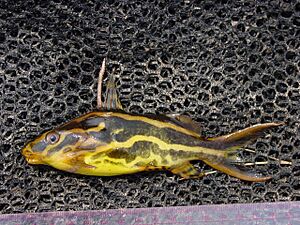Synodontis flavitaeniatus facts for kids
Quick facts for kids Synodontis flavitaeniatus |
|
|---|---|
 |
|
| Conservation status | |
| Scientific classification | |
| Genus: |
Synodontis
|
| Species: |
flavitaeniatus
|
The Synodontis flavitaeniatus is a unique type of upside-down catfish. People call it by many fun names like the orangestriped squeaker, the chocolatestriped squeaker, the yellowstriped squeaker, and even the pyjama Syno. This fish lives in the Democratic Republic of the Congo and the Republic of the Congo. You can find it in the lower and central parts of the Congo Basin.
A scientist named George Albert Boulenger first described this fish in 1919. The name "flavitaeniatus" means "yellow stripes," which perfectly describes its look!
Contents
Discovering the Orangestriped Squeaker
This special fish was first found in the Ruki River. This river is near a place called Eala, which is in the Democratic Republic of the Congo. The first fish studied was collected there.
What Does the Squeaker Look Like?
This fish has a body that is brownish or orange-brown. It has cool yellow and dark brown stripes that go across its body. The bottom of the fish is a lighter brown. It also has small, uneven spots.
Fins and Colors
The fins on its back, sides, and belly are clear. They have dark spots that stand out. The fin near its tail (called the adipose fin) is dark, but its very tip is lighter. The stripes from its body continue onto its tail fin, which is shaped like a deep fork. This fin has light patches on its edges and in the middle.
When the fish feels stressed, its brown color can turn a bit pink! Older fish might look more yellowish-brown.
Special Body Features
Like other fish in its group, the orangestriped squeaker has a bony spike. This spike is called a humeral process. It's connected to a hard cap on the fish's head. You can see it sticking out past its gill opening.
The first ray (or spine) of its back fin and side fins is hard and has a saw-like edge. Its tail fin is deeply forked, and the top part is a bit longer.
Teeth and Whiskers
This fish has short, cone-shaped teeth in its upper jaw. In its lower jaw, the teeth are S-shaped and can move. It has one pair of short whiskers near its mouth. These are called maxillary barbels. It also has two pairs of whiskers on its chin, called mandibular barbels, which are often branched.
How Big Do They Get?
The orangestriped squeaker can grow up to 15.5 centimetres (6.1 in) long. Some fish found in the wild have been even bigger, reaching about 19.5 centimetres (7.7 in) in total length!
Where the Squeaker Lives
In the wild, these fish live in warm, tropical waters. The water temperature is usually between 23 to 28 °C (73 to 82 °F). The water's pH level, which tells you how acidic or basic it is, ranges from 6.5 to 8.0. The water's hardness (dH) is usually between 4 and 25.


